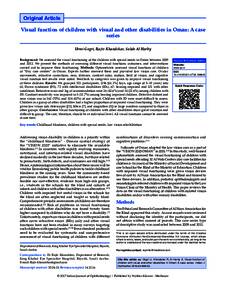Document
Visual function of children with visual and other disabilities in Oman : a case series.
Identifier
DOI: 10.4103/0974-620X.159253
Contributors
Khandekar, Rajiv., Author
Al-Harby, Salah., Author
Publisher
Wolters Kluwer Medknow Publications.
Gregorian
2015-06
Language
English
English abstract
Background : We assessed visual functioning of the children with special needs in Oman between 2009 and 2012. We present the methods of assessing different visual functions, outcomes and interventions carried out to improve their functioning. Materials and Methods : In this case series type of study, optometrists assessed visual functions of children of «day care centers» in Oman. Experts further assessed them and provided low vision care. Ocular movements, refractive corrections, near, distance, contrast color, motion, field of vision and cognitive, visual function test results were noted. Feedback to caregivers was given to improving visual functioning of these children. Results: We grouped 321 participants, (196 (61.1%) boys, age range of 3-18 years) into 61; Down syndrome (DS), 72 with intellectual disabilities, 67; hearing impaired and 121 with other conditions. Refractive error and lag of accommodation was 26 (42.6%) and 14 (22.6%) among children with DS. Contrast sensitivity was impaired in 8 (12.7%) among hearing impaired children. Defective distant and near vision was in 162 (70%) and 104 (42%) of our cohort. Children with intellectual disability were most difficult to assess. Children in group of other disabilities'' had a higher proportion of impaired visual functioning. They were given low vision aids (telescopes (22), filters (7) and magnifiers (3)) in large numbers compared to those in other groups. Conclusions : The outcomes of assessment of visual functioning of children with other disabilities show great variation and difficult to group. The care therefore should be individual. All visual functions cannot be assessed at one time.
Member of
ISSN
0974-620X
Resource URL
Category
Journal articles

